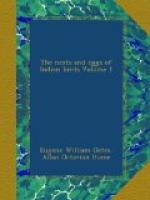Lieut. H.E. Barnes informs us that this Myna breeds in Rajputana during June and July.
Mr. Benjamin Aitken has furnished me with the following interesting note:—“A pair of Mynas clung tenaciously for two years, from June 1863 to August 1865, to a hole in some matting in the upper verandah of a house in Bombay. During this period they hatched six broods, one of which I took and another was destroyed, by rats perhaps. I had a strong suspicion that more than one set of eggs were destroyed besides.
“The remarkable thing I wish to note is that every alternate brood of young contained an albino, pure white and with pink eyes; being three in all. Every time a new set of eggs was to be laid, a new nest was built on the top of the old one. I once tore down the whole pile, as it was infested with vermin, and found that seven nests had been made, one upon another, showing that the Mynas must have occupied the hole long before I noticed them. Each nest was complete in itself and well lined, and as Mynas are not sparing of their materials, the accumulated heap was nearly two feet deep. Every separate nest contained a piece of a snake’s skin, and with reference to your remark on this point I may say that every Myna’s nest that I have ever examined has had a piece of snake-skin in it. This may, I think, be simply accounted for by the fact of snake-skin lying about plentifully in those places where Mynas mostly pick up their building-materials. The breeding-season extends into September in Bombay; and though it usually begins in June, I found a nest of half-fledged young at Khandalla on the 31st May, 1871.
“With reference to your remarks in ‘Nests and Eggs,’ that you have never met with more than five eggs in a nest, I would mention that I took six eggs from a nest in the roof of a house I occupied at Akola, on the 20th June, 1870.
“At the same station in August 1869 a nest of young Mynas was reared above the hinge of the semaphore signal at the railway-station. One or other arm of the signal must have risen and fallen every time a train passed, but the motion neither alarmed the birds nor disarranged the nest.”
Messrs. Davidson and Wenden remark of this Myna in
the
Deccan:—“Common, and breeds in May
and June.”
Mr. J. Inglis, writing from Cachar, says:—“The commonest of all birds here. Breeds throughout the summer months. It makes its nest generally in the roofs of houses or in holes in trees. It lays about five eggs of a very pale blue colour.”
Finally, Mr. Oates writes from Pegu:—“Commences making nest about 15th March. I have taken eggs as late as 17th July, but in this case the previous brood had been destroyed. Normally no eggs are to be found after June.”
The eggs, which are larger than those of either Sturnopastor contra or A. ginginianus, in other respects resemble these eggs greatly, but when fresh are, I think, on the whole of a slightly darker colour. They are rather long, oval, often pear-shaped, eggs, spotless and brilliantly glossy, varying from very pale blue to pure sky- or greenish blue.




